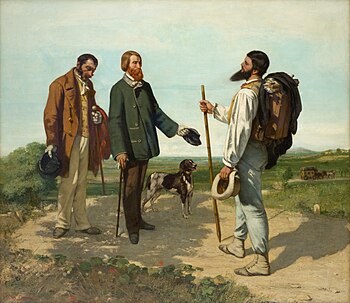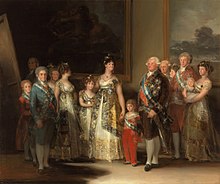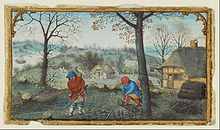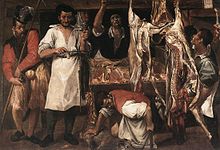Realism (arts)
Naturalism, as an idea relating to visual representation in Western art, seeks to depict objects with the least possible amount of distortion and is tied to the development of linear perspective and illusionism in Renaissance Europe.With artists like Gustave Courbet capitalizing on the mundane, ugly or sordid, realism was motivated by the renewed interest in the common man and the rise of leftist politics.Renaissance theorists opened a debate, which was to last several centuries, as to the correct balance between drawing art from the observation of nature and from idealized forms, typically those found in classical models, or the work of other artists generally.Leonardo da Vinci was one who championed the pure study of nature and wished to depict the whole range of individual varieties of forms in the human figure and other things.[5] Leon Battista Alberti was an early idealizer, stressing the typical,[6] with others such as Michelangelo supporting the selection of the most beautiful – he refused to make portraits for that reason.Scientific methods of representing perspective were developed in Italy in the early 15th century and gradually spread across Europe, with accuracy in anatomy rediscovered under the influence of classical art.This was partly because art was expensive and usually commissioned for specific religious, political or personal reasons, which allowed only a relatively small amount of space or effort to be devoted to such scenes.The Le Nain brothers in France and many Flemish artists including Adriaen Brouwer and David Teniers the Elder and Younger painted peasants, but rarely townsfolk.Much art depicting ordinary people, especially in the form of prints, was comic and moralistic, but the mere poverty of the subjects seems relatively rarely to have been part of the moral message.[10][11][12] According to Ross Finocchio, formerly of the Department of European Paintings at the Metropolitan Museum of Art, Realists used unprettified detail depicting the existence of ordinary contemporary life, coinciding with the contemporaneous naturalist literature of Émile Zola, Honoré de Balzac and Gustave Flaubert.In particular the Peredvizhniki or Wanderers group in Russia who formed in the 1860s and organized exhibitions from 1871 included many realists such as Ilya Repin, Vasily Perov and Ivan Shishkin, and had a great influence on Russian art.[16] It may be regarded as a general attempt to depict subjects as they are considered to exist in third-person objective reality without embellishment or interpretation and "in accordance with secular, empirical rules.As Ian Watt states, modern realism "begins from the position that truth can be discovered by the individual through the senses" and as such, "it has its origins in Descartes and Locke, and received its first full formulation by Thomas Reid in the middle of the eighteenth century.[23][24] Some also specifically cited the invention of photography as the basis of the realist theater[25][26] while others view that the association between realism and drama is far older as demonstrated by the principles of dramatic forms such as the presentation of the physical world that closely matches reality.[32] Italian neorealism filmmakers from after WWII took the existing realist film approaches from France and Italy that emerged in the 1960s and used them to create a politically oriented cinema.[32] Verismo was a post-Romantic operatic tradition associated with Italian composers such as Pietro Mascagni, Ruggero Leoncavallo, Umberto Giordano, Francesco Cilea and Giacomo Puccini.[35] Although an account considered Giuseppe Verdi's Luisa Miller and La traviata as the first stirrings of the verismo,[36] some claimed that it began in 1890 with the first performance of Mascagni's Cavalleria rusticana, peaked in the early 1900s.








Realism (disambiguation)Bonjour, Monsieur CourbetRealistGustave Courbetthe artsartificialityspeculativesupernatural elementslinear perspectiveillusionismRenaissanceacademic artspecific art historical movementFrench Revolution of 1848leftistRomanticismnatural historybiological sciencesverismoliterary realismtheatrical realismItalian neorealist cinemamimesisEarly Netherlandish paintingRobert CampinJan van EyckRealism art movementacademic paintingFrancisco GoyaCharles IV of Spain and His FamilyBaroqueDemetrius of AlopeceAncient Roman RepublicEilif PeterssenChristian artPassiondevotional literatureLate Middle AgesLeonardo da VinciLeon Battista AlbertiMichelangeloHenri BivaMatin à Villeneuvethe CarracciCaravaggistiCaravaggioBelloriJules-Antoine CastagnaryÉmile ZolaImpressionismModernismBarbizon SchoolDüsseldorf School of paintingRegionalismPietàLubiążLower SilesiaPolandNational Museum in WarsawAlexei SavrasovThe Rooks Have ReturnedJean-François RaffaëlliPekka HalonenKareliaLord LeightonCimabue's Celebrated Madonnaperspectiveart of the Upper PaleolithicAncient Egyptian artstylizationAncient Greek artmosaicPliny the ElderZeuxisSocratesRoman portraitureverismBaptism of ChristTurin–Milan HoursHoly GhostLate AntiquityLate medievalEarly Renaissanceoil paintingidealismlandscape in paintingDutch Golden Age paintingStill lifebouquetsLabours of the MonthsSimon BeningDrolleriesilluminated manuscriptsFlandersArnolfini PortraitMerode Altarpiecebooks of hourslandscape artAnnibale CarracciPieter AertsenJoachim BeuckelaerBartolomeo PasserottiPieter Bruegel the Eldergenre paintingBambocciantiLow Countriesbodegoneshistory paintingsJusepe de RiberaVelázquezLe Nain brothersAdriaen BrouwerDavid Teniers the ElderYoungerprintsmarine paintingIndustrial RevolutionJoseph Wright of DerbyPhilip James de LoutherbourgAmerican realismJean-Baptiste GreuzeThe LaundressWilliam Bell ScottLuke FildesAlbert EdelfeltLuxembourg Gardens